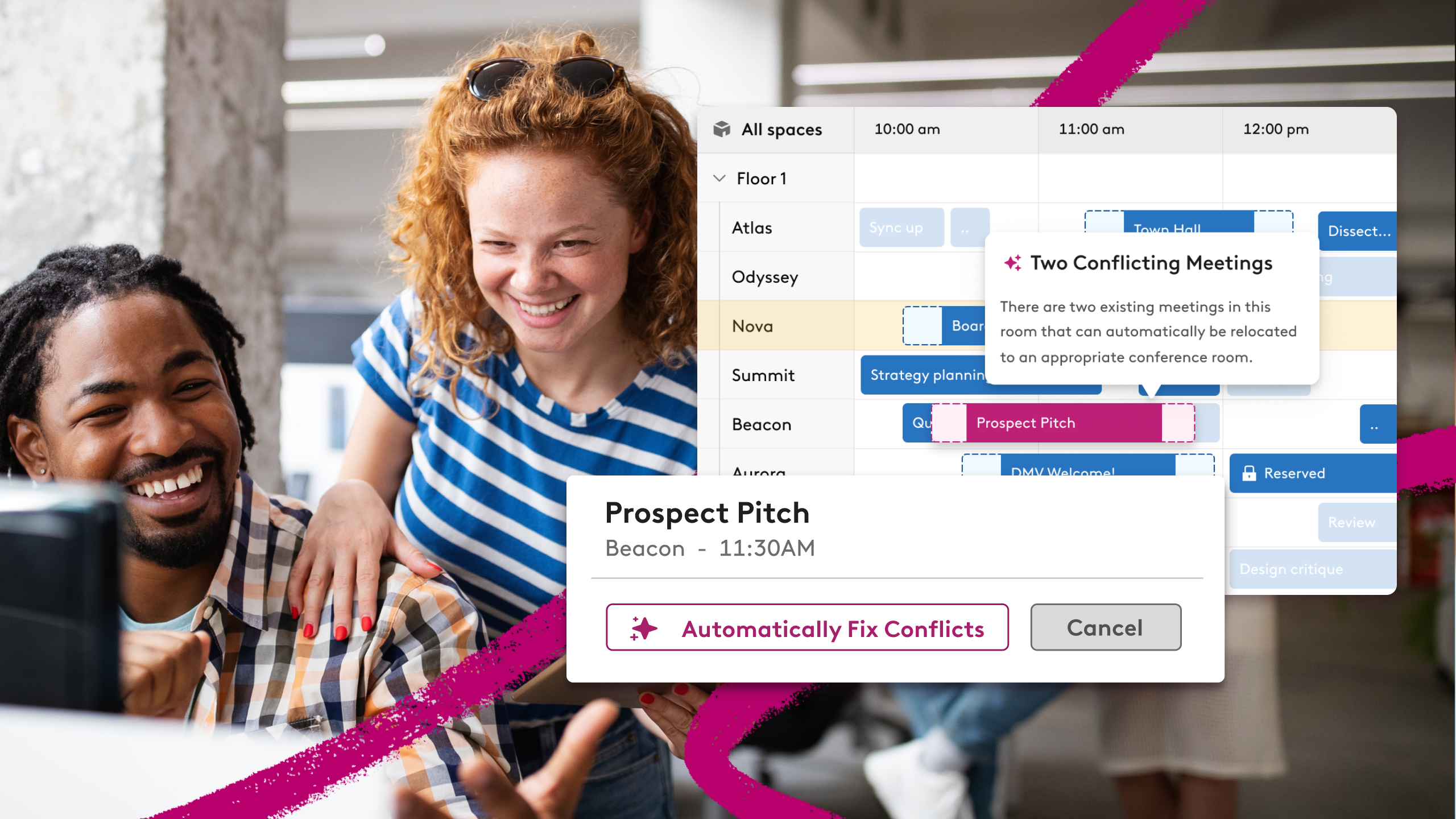Foolproof Your Next Office Move: The Ultimate Planning Guide
.png)
Due to the increasingly fluid nature of workspaces, many companies are reimagining their physical presence. These changes often mean an office move and that means workplace leaders must stay prepared.
Here’s the what, why and how of an effective office move.
How Do You Plan For An Office Move? Things To Consider
If you’re in charge of coordinating your office move in any capacity, odds are you’ve dealt with a change of address before.
But just in case you need a refresher, we have a quick list of things to account for before you start pulling out the company credit card. Let’s run through a few things to consider when planning for your office move:
- Plan and Schedule: Develop a detailed timeline to keep your office move on track and meet crucial deadlines.
- Analyze New Space: Understand IT and spatial capabilities to ensure proper setup in your new office.
- Blueprint the Layout: Create a blueprint to organize where everything should go in the new space.
- Audit Projects: Consider how the move will impact ongoing projects and adjust timelines as needed.
- Set a Budget: Determine your budget to decide if you can outsource logistics or handle them in-house.
Covering Your Bases: A Foundational Office Move Checklist
Now that you have sketched out a plan for attacking the move it’s time to plan some more. In fact, the key to executing your move with as little disruption as possible is planning for every step, scenario and office skeleton. You know what they say: A failure to plan is a plan for failure.
The key to doing it seamlessly (or at least, as seamlessly as possible) is staying organized. That's why we created a foundational checklist that you can personalize to the specific needs of your new office location.
Plan the Logistics
- Review your lease: Check for early termination fines or damage responsibilities.
- Set your budget: Establish a budget 6-8 months ahead to determine moving costs and prioritize spending.
- Consider a moving company: Start gathering quotes 6 months prior and choose one that fits your budget and needs.
- Designate a moving team: Assign a person or team to oversee the move, involving necessary executives as needed.
Communicate with Key Stakeholders
- Notify your landlord: Inform your current landlord early to allow them to find new tenants.
- Update clients: Send emails or newsletters to inform clients about the move.
- Inform the post office and subscriptions: Update your address with the post office and any subscription services.
- Communicate with employees: Inform employees 3-4 months before the move, outlining their responsibilities.
- Assign tasks: Ensure team leaders delegate packing and moving tasks to their teams.
Conduct Audits of Supplies and Equipment
- Audit and order furniture: Tag items for the move and arrange pick-up for unwanted furniture.
- Gather moving supplies: Provide employees with boxes, tape, and labels if they’re packing their own items.
- Transfer utilities: Schedule cancellations and new service start dates.
- Establish security needs: Arrange security services ahead of time.
- Book loading bays: Reserve parking spots for moving day.
- Determine IT needs: Plan IT service setup close to the move date.
Get Ready for Moving Day
- Finalize plans with the moving team: Confirm their schedule and team size.
- Collect access cards: Retrieve old office keys and distribute new ones.
- Backup data: Ensure all important documents are backed up.
- Finish packing and labeling: Complete packing a few days before the move.
Take Advantage of the Opportunity to Reimagine Your Office
Okay bases are loaded and now it’s time to take this thing home. Introducing a new space is a great catalyst for making some bigger structural changes in how your office runs. Here are three areas of the workplace experience that offices everywhere are reconsidering.
Rethink Your Workplace Design
How do you decide what kinds of tasks and spaces need to be supported by a central office campus? What are the advantages of having your employees close to those from other companies, such as in a co-working space? Should you reimagine your office space and allow employees to choose a hybrid model, only coming into the office for part of the time?
According to a framework on the optimal workplace design proposed by Harvard Business School professors Maria Roche and Andy Wu, you should start by asking two questions:
- What is your strategy for future growth?
- What is the size of the organization you need right now?
From there, you should map your answers to better understand how your needs around innovation and execution translate to physical (or virtual) spaces. Remember to also strike a balance between spaces that promote collaboration and those that promote focused work. Gensler’s U.S. Workplace Survey of over 2,000 knowledge workers found that only one in four are in optimal workplace environments. The others are having trouble working efficiently, leading to losses in productivity, innovation and engagement.
Uplevel Office Days with Streamlined Tech
We’ve changed the ways we work, so it makes sense that the technology we use would change too. When big changes happen, introducing new solutions can be easier as teams are already in the mindset of taking on a big change. Think things like: desk booking tools, room scheduling systems, visitor management processes and even office layout management.
For many modern offices, a workplace management platform is a critical tool for all of the above. One of our clients, VHB, uses every major office change or move to introduce Robin to their teams.
“After the [first rollout], we began the process of implementing Robin at each office. Whenever we would do a significant office renovation design or move offices, we would make the transition,” explains VHBs IT Operations leader, Dale Arnt.
“Like, okay we're adding in 20 desks and we're doing some layout changes, it just made sense to introduce Robin as a part of that transition. This new process of 'Hey, I need to book a seat or space and know it's going to be booked when I get there and I want to be able to do that in an easy way.’ Robin was built for that."
Prioritize Better Experiences for In-Person Work
The foundation of any company is its people. And in the current landscape, employees want the flexibilty that comes with more flexible schedules and the energy and camaraderie that comes from purposeful, productive office days.
While employees may be hesitant to come into the office at first, once they do get there, they feel more connected to their teams. In fact, 73% of respondents reported feeling more connected to their company when in-office with their colleagues, yet 64% of people feel indifferent when their teams are in the office without them.
Like many things in life, the things that are most worth doing can feel difficult at first. No one wants to make the trip to the gym, but don't we all feel better after we have? It may be true that it’s an employer’s market, but every company wants the top talent . In order to attract (and retain) high-performers, organizations must be mindful of creating experiences and connections that keep people working on their team.
So, how do you get a handle on employee experience? Ask them directly. Create focus groups or surveys to determine which aspects of their environment impede work or are just plain uninspiring.
As Francis Aquino, Director of Workplace & Employee Experience at Honey, told Workplace Unplugged:
“To improve employee experience, it’s very important to get to know the individual culture, voice, and inner quirks of a certain environment within an industry. Spending a good amount of time in the discovery and immersion stage almost guarantees a successful implementation.”
Moving offices for a changing workforce
No move ever goes perfectly. Whether you’re moving to a new house or changing office locations, by referring back to a moving checklist, you can help minimize frustrations and help employees transition to a new location.
Change is hard but in this new world of remote and hybrid work, flexibility is the key to ensuring that an office move goes smoothly.
Ready to start planning for a flawless office move? Check out how Robin's platform can help.












